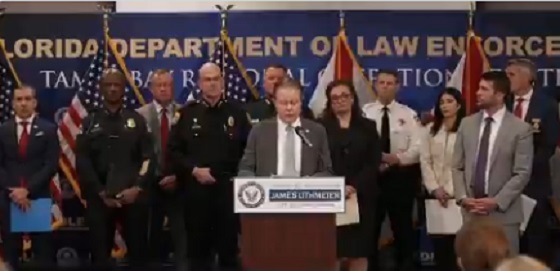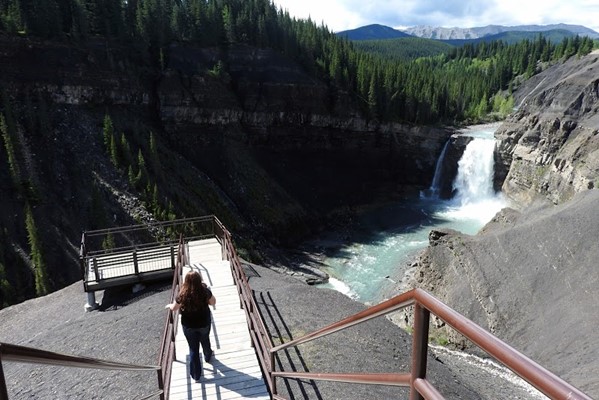Business
Natural gas pipeline ownership spreads across 36 First Nations in B.C.

Chief David Jimmie is president of Stonlasec8 and Chief of Squiala First Nation in B.C. He also chairs the Western Indigenous Pipeline Group. Photo courtesy Western Indigenous Pipeline Group
From the Canadian Energy Centre
Stonlasec8 agreement is Canada’s first federal Indigenous loan guarantee
The first federally backed Indigenous loan guarantee paves the way for increased prosperity for 36 First Nations communities in British Columbia.
In May, Canada Development Investment Corporation (CDEV) announced a $400 million backstop for the consortium to jointly purchase 12.5 per cent ownership of Enbridge’s Westcoast natural gas pipeline system for $712 million.
In the works for two years, the deal redefines long-standing relationships around a pipeline that has been in operation for generations.
“For 65 years, there’s never been an opportunity or a conversation about participating in an asset that’s come through the territory,” said Chief David Jimmie of the Squiala First Nation near Vancouver, B.C.
“We now have an opportunity to have our Nation’s voices heard directly when we have concerns and our partners are willing to listen.”
Jimmie chairs the Stonlasec8 Indigenous Alliance, which represents the communities buying into the Enbridge system.
The name Stonlasec8 reflects the different regions represented in the agreement, he said.
The Westcoast pipeline stretches more than 2,900 kilometres from northeast B.C. near the Alberta border to the Canada-U.S. border near Bellingham, Wash., running through the middle of the province.

It delivers up to 3.6 billion cubic feet per day of natural gas throughout B.C. and the Lower Mainland, Alberta and the U.S. Pacific Northwest.
“While we see the benefits back to communities, we are still reminded of our responsibility to the land, air and water so it is important to think of reinvestment opportunities in alternative energy sources and how we can offset the carbon footprint,” Jimmie said.
He also chairs the Western Indigenous Pipeline Group (WIPG), a coalition of First Nations communities working in partnership with Pembina Pipeline to secure an ownership stake in the newly expanded Trans Mountain pipeline system.
There is overlap between the communities in the two groups, he said.
CDEV vice-president Sébastien Labelle said provincial models such as the Alberta Indigenous Opportunities Corporation (AIOC) and Ontario’s Indigenous Opportunities Financing Program helped bring the federal government’s version of the loan guarantee to life.
“It’s not a new idea. Alberta started it before us, and Ontario,” Labelle said.
“We hired some of the same advisors AIOC hired because we want to make sure we are aligned with the market. We didn’t want to start something completely new.”
Broadly, Jimmie said the Stonlasec8 agreement will provide sustained funding for investments like housing, infrastructure, environmental stewardship and cultural preservation. But it’s up to the individual communities how to spend the ongoing proceeds.
The long-term cash injections from owning equity stakes of major projects can provide benefits that traditional funding agreements with the federal government do not, he said.
Labelle said the goal is to ensure Indigenous communities benefit from projects on their traditional territories.
“There’s a lot of intangible, indirect things that I think are hugely important from an economic perspective,” he said.
“You are improving the relationship with pipeline companies, you are improving social license to do projects like this.”
Jimmie stressed the impact the collaborative atmosphere of the negotiations had on the success of the Stonlasec8 agreement.
“It takes true collaboration to reach a successful partnership, which doesn’t always happen. And from the Nation representation, the sophistication of the group was one of the best I’ve ever worked with.”
Alberta
Canadian Oil Sands Production Expected to Reach All-time Highs this Year Despite Lower Oil Prices

From Energy Now
S&P Global Commodity Insights has raised its 10-year production outlook for the Canadian oil sands. The latest forecast expects oil sands production to reach a record annual average production of 3.5 million b/d in 2025 (5% higher than 2024) and exceed 3.9 million b/d by 2030—half a million barrels per day higher than 2024. The 2030 projection is 100,000 barrels per day (or nearly 3%) higher than the previous outlook.
The new forecast, produced by the S&P Global Commodity Insights Oil Sands Dialogue, is the fourth consecutive upward revision to the annual outlook. Despite a lower oil price environment, the analysis attributes the increased projection to favorable economics, as producers continue to focus on maximizing existing assets through investments in optimization and efficiency.
While large up-front, out-of-pocket expenditures over multiple years are required to bring online new oil sands projects, once completed, projects enjoy relatively low breakeven prices.
S&P Global Commodity Insights estimates that the 2025 half-cycle break-even for oil sands production ranged from US$18/b to US$45/b, on a WTI basis, with the overall average break-even being approximately US$27/b.*
“The increased trajectory for Canadian oil sands production growth amidst a period of oil price volatility reflects producers’ continued emphasis on optimization—and the favorable economics that underpin such operations,” said Kevin Birn, Chief Canadian Oil Analyst, S&P Global Commodity Insights. “More than 3.8 million barrels per day of existing installed capacity was brought online from 2001 and 2017. This large resource base provides ample room for producers to find debottlenecking opportunities, decrease downtime and increase throughput.”
The potential for additional upside exists given the nature of optimization projects, which often result from learning by doing or emerge organically, the analysis says.
“Many companies are likely to proceed with optimizations even in more challenging price environments because they often contribute to efficiency gains,” said Celina Hwang, Director, Crude Oil Markets, S&P Global Commodity Insights. “This dynamic adds to the resiliency of oil sands production and its ability to grow through periods of price volatility.”
The outlook continues to expect oil sands production to enter a plateau later this decade. However, this is also expected to occur at a higher level of production than previously estimated. The new forecast expects oil sands production to be 3.7 million b/d in 2035—100,000 b/d higher than the previous outlook.
Export capacity—already a concern in recent years—is a source of downside risk now that even more production growth is expected. Without further incremental pipeline capacity, export constraints have the potential to re-emerge as early as next year, the analysis says.
“While a lower price path in 2025 and the potential for pipeline export constraints are downside risks to this outlook, the oil sands have proven able to withstand extreme price volatility in the past,” said Hwang. “The low break-even costs for existing projects and producers’ ability to manage challenging situations in the past support the resilience of this outlook.”
* Half-cycle breakeven cost includes operating cost, the cost to purchase diluent (if needed), as well as an adjustment to enable a comparison to WTI—specifically, the cost of transport to Cushing, OK and quality differential between heavy and light oil.
About S&P Global Commodity Insights
At S&P Global Commodity Insights, our complete view of global energy and commodity markets enables our customers to make decisions with conviction and create long-term, sustainable value.
We’re a trusted connector that brings together thought leaders, market participants, governments, and regulators and we create solutions that lead to progress. Vital to navigating commodity markets, our coverage includes oil and gas, power, chemicals, metals, agriculture, shipping and energy transition. Platts® products and services, including leading benchmark price assessments in the physical commodity markets, are offered through S&P Global Commodity Insights. S&P Global Commodity Insights maintains clear structural and operational separation between its price assessment activities and the other activities carried out by S&P Global Commodity Insights and the other business divisions of S&P Global.
S&P Global Commodity Insights is a division of S&P Global (NYSE: SPGI). S&P Global is the world’s foremost provider of credit ratings, benchmarks, analytics and workflow solutions in the global capital, commodity and automotive markets. With every one of our offerings, we help many of the world’s leading organizations navigate the economic landscape so they can plan for tomorrow, today. For more information visit https://www.spglobal.com/commodity-insights/en.
SOURCE S&P Global Commodity Insights
Business
Federal government should finally cut Trudeau-era red tape

From the Fraser Institute
If Prime Minister Carney really wants to show he’s committed to “Building Canada” he’d ceremoniously defenestrate Bill C-48, scap the cap on Canadian Oil and Gas related greehhouse gas emissions, and ax the so-called Clean Electricity Regulations
As pretty much everyone knows, Canada has a building problem. Whether it’s provincial building of housing or infrastructure, or national building of highways, pipelines or energy production facilities, Canada can seemingly not get things built no matter how many companies and investors propose projects (or how many newspaper opinion columns or public opinion polls shows that people want things built).
The Carney government appears to recognize this problem and recently introduced Bill C-5. Of course, appearances can be deceiving. Superficially, a lot of what’s in the proposed bill sounds good: facilitating free trade and labour mobility inter-provincially, and ostensibly streamlining government’s regulatory powers to facilitate the timely building of projects deemed to be in Canada’s national interests. Who could be against that?
Per the government, the “Bill seeks to get projects in the national interest built by focusing on a small number of executable projects and shifting the focus of federal reviews from ‘whether’ to build these projects to ‘how’ to best advance them.” Again, looks great, but even a cursory reading by a legal layman reveals the fact that, in reality, little has changed in regard to the approval of major building projects in Canada. Just as it is now, under the new regime, the prime minister’s office (and designees elsewhere in government) ultimately have carte blanche in deciding whether or not projects of significance can be built in Canada, under what timeline, and based on whatever criteria they deem appropriate.
All that is better than nothing, of course, but words (particularly political words) are cheap and actions more valuable. If Prime Minister Carney really wants to show he’s committed to “Building Canada” he’d ceremoniously defenestrate Bill C-48 (a.k.a. the “Tanker Ban Bill”), which came into effect last year under the Trudeau government and changed tanker regulations off British Columbia’s northern coast, torpedoing any prospects of building oil export pipelines on Canada’s west coast.
He could also scrap the cap on Canadian oil and gas-related greenhouse gas emissions (introduced by the Trudeau government in 2024) and regulations (also introduced in 2024) for methane emissions in the oil and gas sector, both of which will almost inevitably raise costs and curtail production.
Finally, the prime minister could ax the so-called “Clean Electricity Regulations” that will likely drive electricity rates through the roof while ushering in an age of less-reliable electricity supply and less building of conventional energy-generation from natural gas, a fuel far more reliable than Canada’s fickle winds and often-tepid sunlight. By driving up energy costs across Canada and through the entire chain of production and service economies, these regulations (again, enacted by the Trudeau government) will make it more expensive to build anything anywhere in Canada.
Prime Minister Carney has made some nice noises seemingly recognizing that Canada has a building problem, particularly with regard to energy projects, and Bill C-5 makes equally nice (yet ill-defined) noises about regulatory reform in the energy and natural resource sectors. But Canada doesn’t have a shortage of nebulous government pronouncements; it has an overdose of regulatory restrictions preventing building in Canada. He should show real seriousness and eliminate the raft of Trudeau-era red tape stifling growth and development in Canada.
And sooner is better than later. Canada’s biggest economic competitors (not only the United States) are not sitting on their red-taped hands watching their economies decline.
-

 Also Interesting2 days ago
Also Interesting2 days agoTop 7 Features Every Canadian Home Care Agency Needs in Their Home Care Software
-

 conflict2 days ago
conflict2 days agoWar over after 12 days? Ceasefire reached between Israel, Iran
-

 Crime2 days ago
Crime2 days agoFlorida rescues 60 missing kids in nation’s largest-ever operation
-

 Also Interesting2 days ago
Also Interesting2 days agoDiscover hidden paths – Uncover nature’s secrets in Central Alberta
-

 Business2 days ago
Business2 days agoCanada should already be an economic superpower. Why is Canada not doing better?
-

 Business2 days ago
Business2 days agoYounger Casino Bettors Are Upping the Ante on Risky Gambling in British Columbia, Documents Show
-

 Business2 days ago
Business2 days agoWhile China Hacks Canada, B.C. Sends Them a Billion-Dollar Ship Building Contract
-

 Bjorn Lomborg1 day ago
Bjorn Lomborg1 day agoThe Physics Behind The Spanish Blackout







